
“The next generation do not know about it. I talk to them, but it’s not like a film. If I tell them it may not stick, this way is more permanent.”
The struggle for the independence of the Kurdish people cuts across countries, religions, cultures, and ethnicities. It is a story never told in a museum before. How can an exhibition tell this contested story and bring together a diversity of views?
This question was at the heart of planning the Kurdistan Museum, a national institution which will be built in Erbil by the Kurdistan Region Government (KRG) in the coming years. It will be the first major museum of Kurdish history and culture. Emmy award-winning company RWF World have been working on behalf of the KRG and have recruited both Studio Libeskind and Haley Sharpe Design (hsd) for this project. hsd’s scope included the experience’s master-planning, interpretation and content, and media development. The main assets for the exhibition are powerful testimonies filmed by RWF World, who have traveled throughout Kurdistan to interview survivors of executions, gas attacks, deportation, displacement, and imprisonment. This repository of material is preserved by the Kurdistan Memory Programme (KMP)—a new national digital archive which is documenting the Kurdish story for the world.
Faced with the challenge to represent an experience that is contested and contentious, hsd wanted to share our reflections on the process of planning and designing the permanent exhibition for the Kurdistan Museum.
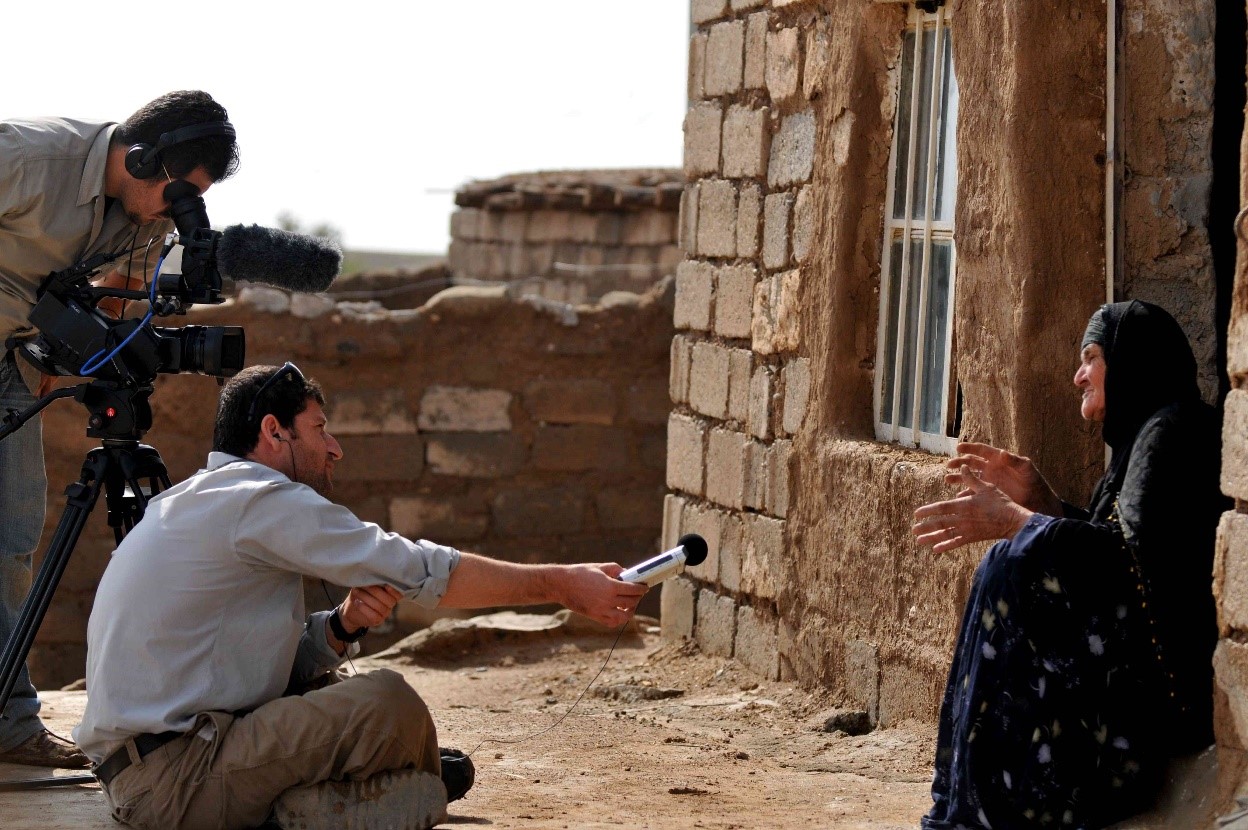
One story, many voices
Working in collaboration with the museum team, our aim for the exhibition was to create a walkthrough of Kurdish history—a history that has traditionally been suppressed and is mostly unknown to Western audiences and even younger generations of Kurds. For these reasons, we wanted to tell a coherent story with a clear layout highlighting key moments.
We were careful not to use one voice to tell this history. Fortunately, we had a rich archive of testimonies, on paper and film, which represented the diversity of Kurdish people. These voices were an essential resource, giving us multiple perspectives to develop the key narrative.
During the design’s development, we explored different options to create the narrative spaces. First, we considered dividing the story into four parts, reflecting both the architecture of the building and the convergence of Iraq, Syria, Turkey, and Iran. But this did not work well with the intertwining assets and stories. Another way we considered was to cut across these national boundaries using the big themes of culture, repression, and resilience. During team workshops, however, it became clear that the Anfal Campaigns and their impact on Kurdish identity are the main focal point and needed to be emphasized in the approach we took. A linear layout allowed us to use the film collection where it was strongest and work with the architecture to pace the experience and build momentum. The result is a chronological journey—the Road to Anfal.
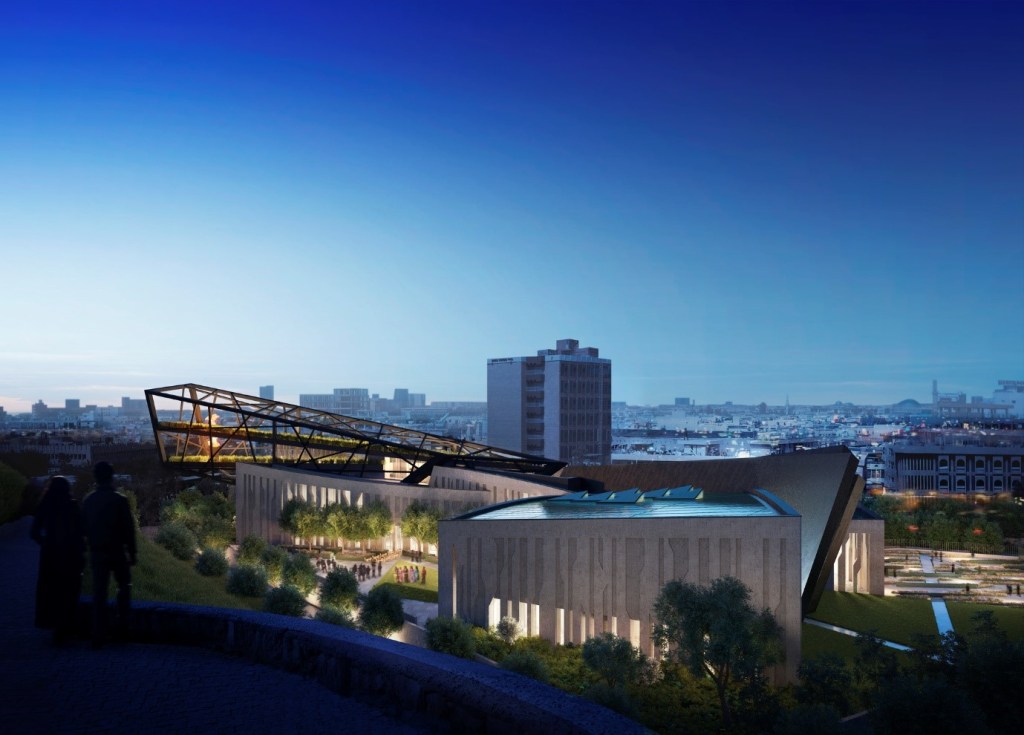
Anfal was a series of eight military campaigns conducted by the Iraqi government against rural Kurdish communities in Iraq, which lasted from February 23 until September 6 in 1988. The exhibition will give visitors perspective on the conflict by taking them on a journey from 1880 to the present day, and will depict the struggle for self-rule, the tragedy and horror of Anfal, and other savage attempts to destroy Kurdish life and culture. This chronological route is structured into ten areas.
To start the journey, visitors climb up the stairs and are greeted by a large screen with a breathtaking landscape scene of the Zagros Mountains. These mountains have a special meaning in Kurdish history. They offered retreat and safety for thousands of years. They have shaped and inspired Kurdish identity and are the stage for the historic events the exhibition will explore.
The Anfal Campaigns sit in the middle of the experience, in the largest space, just before visitors walk through the Anfal Line—a dramatic piece of architecture reflecting the painful memory of the Kurdish people. This area will highlight Saddam Hussein’s systematically planned attempt to destroy the Kurdish people through mass killings, chemical weapons, deportation, and village destruction. Sensitive and emotive films will contrast with the records of cold military planning and show the personal consequences of Anfal for civilians and armed fighters alike. The exhibition will not only portray Kurds as victims but highlight the tremendous psychological strength they showed in maintaining their identity throughout Anfal, by continuing to fight, write diaries, and conduct prayers. Break-out spaces, off the linear course and along the inner courtyard, invite visitors to contrast, compare, and reflect on the main narrative.
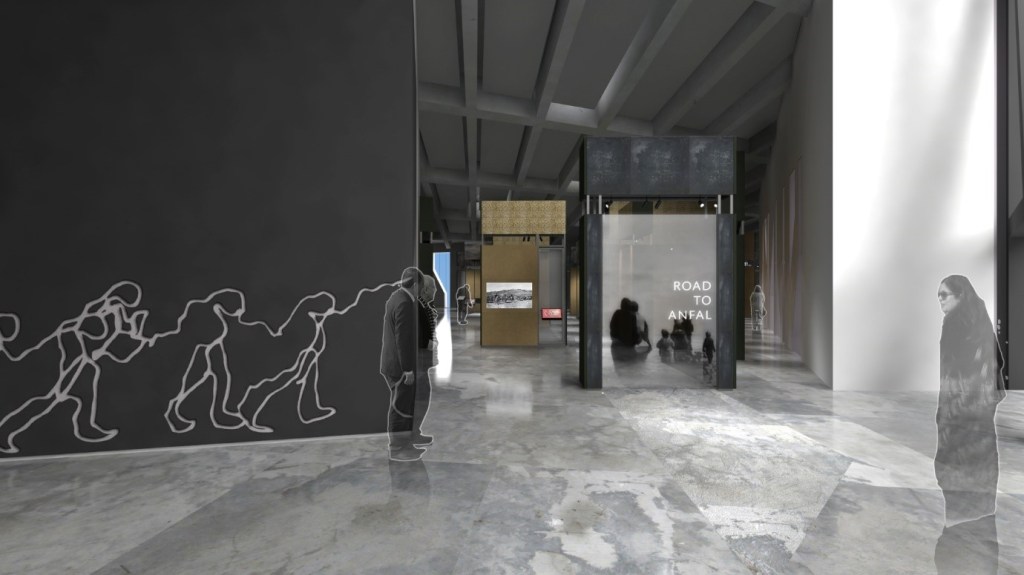
© hsd. Copyrighted Image—no reproduction without permission.

© hsd. Copyrighted image—no reproduction without permission.
Only a few artifacts were available to tell the story. We carefully displayed them to anchor key moments on the timeline and give emphasis to personal stories. At the end of the journey the scarcity of artifacts is replaced by a rich and colorful display of current Kurdish material culture, fashion and textiles celebrating the overcoming of tyranny. The architecture supports this notion with a line to an ‘eternal fire’ which burns for an ancient civilization achieving self-determination, self-expression, and a bright and peaceful future through greater self-knowledge.
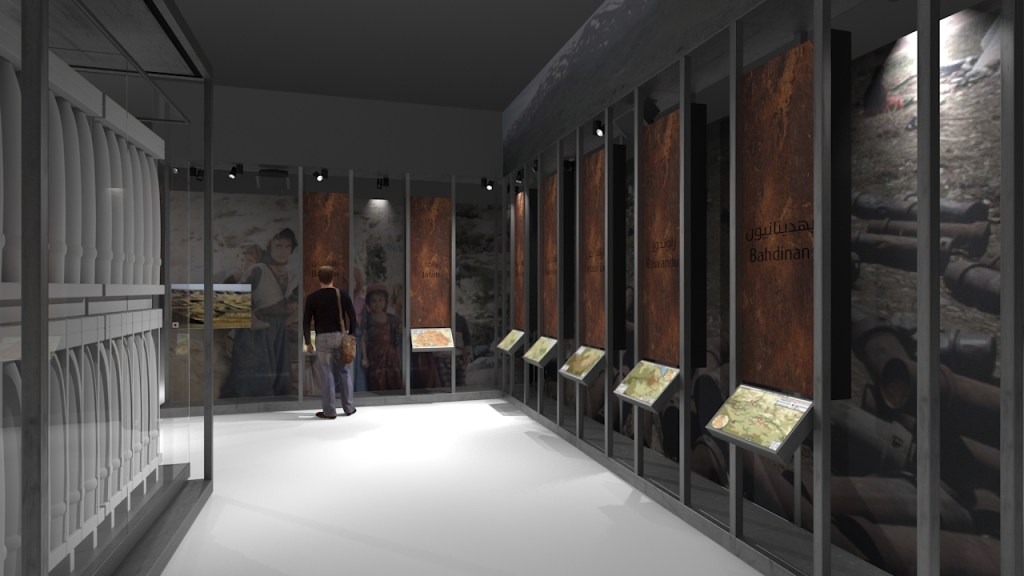
Our next challenge was how to tell this story with many voices, and in multiple languages, yet give visitors enough guidance to understand the context for the key events. One of the media solutions was to use a small audio guide, which plays sound bites triggered by infrared signals. Visitors can simply point the guide to an audio-visual screen or object and start listening. The audio guide allowed us to include the main Kurdish languages Sorani and Kurmanji, as well as Arabic and English. This way, not one language dominates the exhibition. Visitors can simply choose their language at the entrance and the infrared trigger will play content near the media stations. This freed the graphic styling from word-heavy text, and we could give all real estate to the impactful and evocative photographs, illustrations, and films.
The audio guide has two functions. It gives visitors a coherent main narrative that guides them through the exhibition, and it gives them access to the multiple films that are displayed in the gallery, which exposes them to multiple voices. Visitors can hear and see Kurdish history from many viewpoints: children, women, political leaders, villagers, teachers, poets, peshmerga military forces, journalists, doctors, and many more. Where appropriate we included opportunities for debate and discussion. Kurdish history is full of events that are still passionately discussed and divide opinions amongst different groups. We created opportunities for visitors to engage with the complexities of history rather than offering a reductive storyline in an authoritative museum voice.
Creating the exhibition as the Road to Anfal meant that the focus after the 1940s was on Iraqi Kurdish history. But what about Kurds in Syria, Iran, and Turkey, and the Kurdish diaspora elsewhere? To provide this context, we placed large touch-tables in each exhibit zone where visitors can choose to explore what happened to Kurds outside Iraq.
Exhibiting the dark side of human nature
One of the most challenging aspects of the project was how to represent atrocities in the exhibition, especially the ones that are still within living history of our visitors. Anfal was a series of extreme events in which human life was devalued in a shocking manner. There were heated debates during team workshops. Should we display detailed imagery of atrocities? Should this gruesome imagery be used as powerful evidence to show what has happened to the Kurds? How could we show this imagery in a respectful way to the victims and their families? Would we risk (re)traumatizing visitors with imagery that is too graphic?
While the violent nature of these events cannot be denied, the display of these pictures needs to be sensitively handled, respecting the traumatic and painful experiences of the survivors. We decided that episodes of violence will be set within the context in which they occurred. The focus will be on the realities and impact of violence on human beings, and the survivors’ personal testimonies will have the most presence in the exhibition. RWF’s filmmakers skilfully combined survivors’ voices with landscape scenery and archival imagery to make poignant cinematic shows which captured the emotional trauma of the story.
We used these shows to create a variety of immersive experiences. In one, the testimony of the survivors of gas attacks is projected at larger-than-life scale. The sound of their trembling voices echoes through the exhibition space. The shadow and sound of a fighter jet creates a feeling of the danger of the attack. Ghostly imagery of refugees walking is projected onto thin glass blades, inviting visitors to walk with them.
Not all stories spill out into the exhibition in this way. Smaller screens tell individual stories on an intimate level, some so delicate that visitors need to peek through a wall to see them. Beautiful animations help visitors imagine the stories that have left no visual record. Iconic photographs are printed at large scale and supported by poignant quotes. In the background, a bespoke soundtrack gives visitors an emotional sense of each decade of Kurdish history.
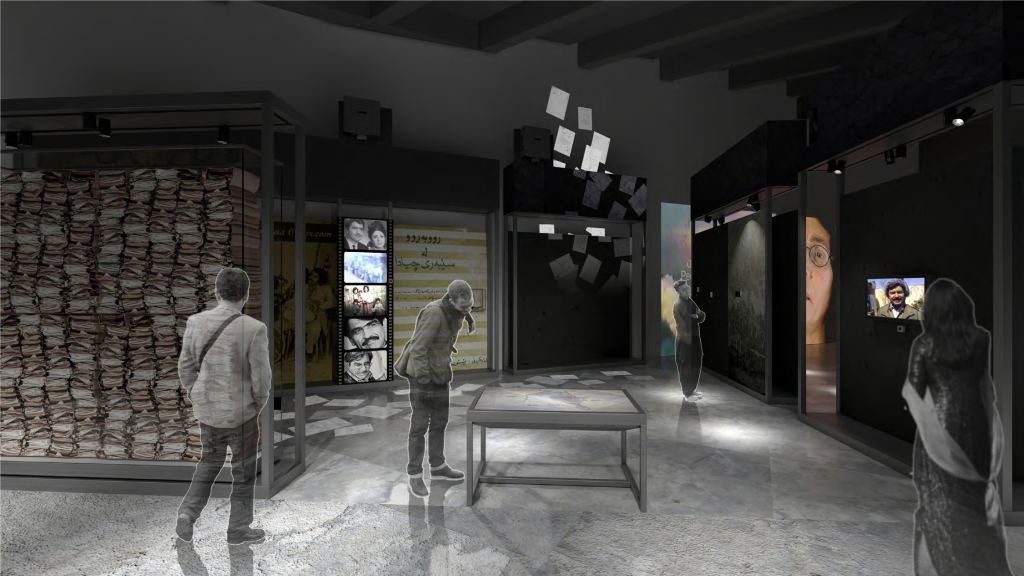
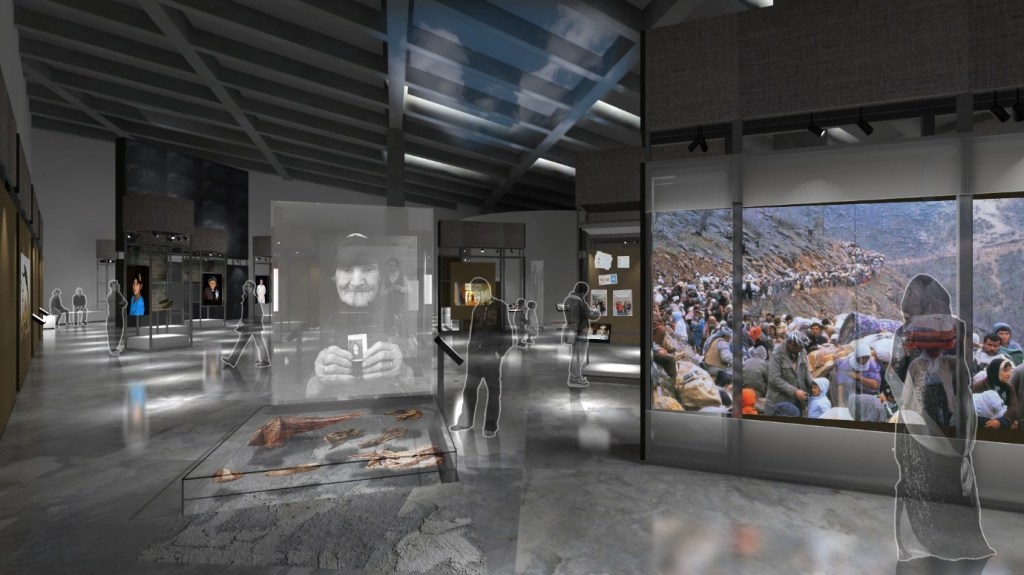
Telling stories that have mostly been ignored is part of the documentary function of the museum. We carefully balanced this mandate with its commemorative function. We built in ample seating areas and break-out spaces overlooking the inner courtyard, allowing visitors to step out of the main narrative to rest and reflect. Trained front-of-house staff will be there to support visitors when required.
Creating platforms for dialogue in the future
The KMP’s collection of powerful memories and stories of the Kurdish people was a significant asset to the project. Without it the exhibition could not display such a rich variety of images, voices, and emotions. Kurdish visitors can hear and see people who look and sound like them and may have similar lived experiences, instead of only encountering expert authorities interpreting their history.
As exhibit planners, our aim is to inspire visitors to contribute their memories and become part of the debate on the future of the Kurdish people. The Kurdistan Museum will have a professional recording studio and editing suite, where visitors will be invited to share their memories and will be guided through the process by trained museum staff onsite. The experience and skill of the KMP in conducting interviews and collecting oral histories will be embedded into the new institution and its operational capacities. Over time, the output will be a high-quality database of the Kurdish experience accessible to everyone.
We planned the exhibition so it can be updated to include new memories being recorded in the museum. This way, the exhibition can absorb a wider diversity of voices. The Road to Anfal exhibition is just one way in which the museum is communicating Kurdish history to a greater audience. The institution has space for lively programs, events, and workshops; including special exhibition spaces, an auditorium, a café, and a garden. These spaces will allow the museum to grow with time.
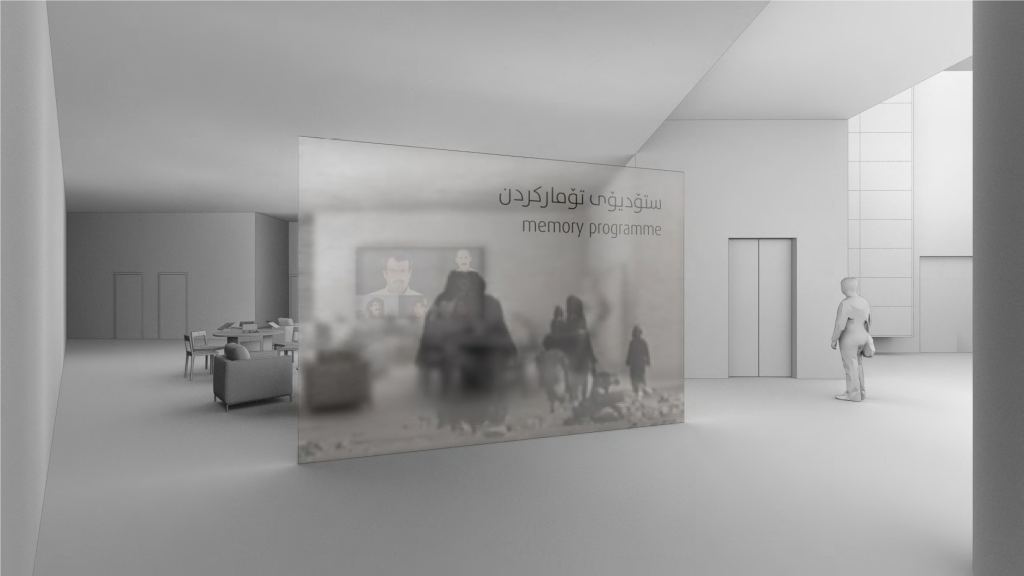
About the author:
Christine Echtner is an interpretive planner for Haley Sharpe Design. She has applied her academic background in English and History while developing interpretive plans and managing content for exhibition projects such as the Kurdistan Museum, Oman Botanic Garden and Smithsonian’s National Air and Space Museum.








